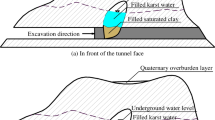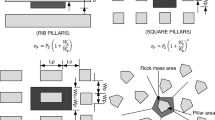Abstract
Water-bearing caves in the Maokou limestone have caused disastrous water inrushes in mines in southern China. A linkage analysis between the hydro-mechanical coupling and the strength reduction method was used to investigate the stability of water-resistant rock pillars. The factor of safety (FOS) of the pillar was established, and a criterion for establishing the required width of the pillar was proposed in engineering practice, i.e., the width of the pillar should be based on the blast hole depth and blast-disturbance depth, along with a FOS of 1.5. The permeability of the water-resistant pillar and the probability of water inrush both increase as the strength reduction factor increases because the effective width of the pillar narrows. A numerical analysis of the Qiyi coal mine “4·16” water inrush accident shows that the cause of the inrush was that the 3.0 m wide barrier left by roadway excavation was too narrow to withhold the karst water pressure of about 4.0 MPa.
Zusammenfassung
Die häufig vorhanden wassererfüllten Hohlräume im Maokou-Kalkstein können katastrophale Wassereinbrüche bei Bergbauaktivitäten in Südchina bewirken. Durch die Verwendung von Verküpfungsanalysen zwischen einen gekoppelten hydromechanischen Model (HM) und einer Festigkeits-Reduktions-Methode (SRM) wurde die Stabilität der Wassersicherheitspfeiler untersucht. Der Sicherheitsfaktor (factor of safety, FOS) der Pfeiler wurde festgelegt und als Kriterium für benötigte Breite der Pfeiler in Ingenieurpraxis vorgeschlagen. Beispielsweise wird die Pfeilerbreite auf Grundlage der Bohrlochtiefe und des -einflusses mit einem FOS-Wert von 1.5 festgelegt. Die Permeabilität der Wassersicherheitspfeiler und die Wahrscheinlichkeit eines Wassereinbruchs steigen mit der Erhöhung festigkeitsmindernder Faktoren, ausgedrückt durch einen Festigkeits-Reduktions-Faktor, aufgrund des veränderten Wertes für die effektive Pfeilerschlankheit. Eine numerische Analyse des “4*16-Qiyi Kohlenbergbau-Unfalls” zeigt, dass die Ursache für den Wassereinbruch in einer für einen Karstwasserdruck von ungefähr 4.0 MPa mit 3.0 m zu schmal bemessenen Stecken-Barriere lag.
Resumen
Las cuevas que contienen agua están ampliamente distribuidas en la piedra caliza Maoko y han causado desastrosas irrupciones de agua en el sur de China. Se utilizó un análisis integrando el acoplamiento hidromecánico y el método de reducción de la resistencia para investigar la estabilidad de los pilares de roca resistentes al agua. Se investigó el factor de seguridad de los pilares (FOS) y se propuso un criterio para establecer el espesor requerido para los pilares, i.e., el espesor debería ser calculado en base a las profundidades del agujero de la explosión y de la perturbación provocada por ésta, junto con un FOS de 1.5. Tanto la permeabilidad del pilar resistente al agua como la probabilidad de irrupción de agua se incrementan cuando el factor de reducción de la resistencia se incrementa porque el ancho efectivo del pilar se estrecha. Un análisis numérico del accidente de irrupción de agua en la mina de carbón Qiyi “4*16” muestra que la causa de la irrupción fue que la barrera de 3.0 m de ancho sobre la izquierda de la excavación era demasiada delgada para contener la presión de agua karst de alrededor de 4.0 MPa.
摘要
茅口灰岩富水岩溶发育是众多中国 南方诸多煤矿突水的重要原因。基于渗流-应力耦合与强度折 减法分析了防水煤岩柱稳定性,建立防水煤岩柱安全因子(FOS)。在工程实践基础上提出防水煤岩柱宽度标准,防水煤岩柱宽度应考虑爆炸孔深度和爆炸影响深度,安全因子(FOS)达1.5。当强度折 减因子增大时,有效防水煤岩柱宽度减小,防水煤岩柱渗透性和突水性同时增加。湖南七一煤矿“4•16”突水事故模拟结果显示,大巷回采仅保留3m宽防水煤岩柱不足以抵抗4MPa水压是引发突水事故主要原因。












Similar content being viewed by others
References
Cheng YM, Lansivaara T, Wei WB (2007) Two-dimensional slope stability analysis by limit equilibrium and strength reduction methods. Comput Geotech 34:137–150
Cundall PA (2001) FLAC manual: a computer program for fast lagrangian analysis of continua. 1st revision. Itasca Consulting Group Inc, Minneapolis
Dai S, Ren D, Tang Y, Yue M, Hao L (2005) Concentration and distribution of elements in Late Permian coals from western Guizhou Province, China. Int J Coal Geol 61(1):119–137
David C, Menendez B, Zhu W, Wong TF (2001) Mechanical compaction, microstructures and permeability evolution in sandstones. Phys Chem Earth (A) 26: 45–51
Dawson EM, Roth WH, Drescher A (1999) Slope stability analysis by strength reduction. Geotechnique 49(6):835–840
Griffiths DV, Lane PA (1999) Slope stability analysis by finite elements. Geotechnique 49(3):387–403
Guo H, Adhikary D, Craig M (2009) Simulation of mine water inflow and gas emission during longwall mining. Rock Mech Rock Eng 42(1):25–51
He KQ, YU YJ, Fei W (2011) Overview of karst geo-environments and karst water resources in north and south China. Environ Earth Sci 64:1865–1873
He KQ, Wang RL, Jiang WF (2012) Groundwater inrush channel detection and curtain grouting of the Gaoyang iron ore mine, China. Mine Water Environ 31(4):297–306
Itasca Consulting Group Inc (2002) Fast Lagrangian analysis of continua in 3-Dimensions. Itasca Consulting Group, Minnesota
Jing L (2003) A review of techniques, advances and outstanding issues in numerical modelling for rock mechanics and rock engineering. Int J Rock Mech Min 40(3):283–353
Li SP, Li YS, Li Y, Wu ZY, Zhou G (1994) Permeability-strain equations corresponding to the complete stress-strain path of Yinzhuang sandstone. Int J Rock Mech Min Sci Geomech Abstr 31(4):383–391
Li LH, Yang TH, Liang ZZ, Zhu WC, Tang CA (2011) Numerical investigation of groundwater outbursts near faults in underground coal mines. Int J Coal Geol 85(3):276–288
Lin H, Cao P, Li JT, Jiang XL, He ZM (2010) Deformation stability of three-dimensional slope based on Hoek-Brown criterion. Rock Soil Mech 31:3656–3660 (Chinese)
Louis C (1974) Rock hydraulics. In: Muller L (ed) Rock mechanics. Springer, New York, pp 300–387
Lu Y, Wang L (2015) Numerical simulation of mining-induced fracture evolution and water flow in coal seam floor above a confined aquifer. Comput Geotech 67:157–171
Matsui T, San KC (1992) Finite element slope stability analysis by shear strength reduction technique. Soils Found 32(1):59–70
Miao XX, Wang A, Sun YJ (2009) Research on theory of mining with water resources protection and its application to arid and semi-arid mining region. Chin J Rock Mech Eng 28(2):217–227 (In Chinese)
Miao XX, Cui XM, Wang JA, Xu JL (2011) The height of fractured water-conducting zone in undermined rock strata. Eng Geol 20(1):32–39
Shi L, Singh RN (2001) Study of mine water inrush from floor strata through faults. Mine Water Environ 20(3):140–147
Sun W, Wu Q, Dong D, Jiao J (2012) Avoiding coal–water conflicts during the development of China’s large coal-producing regions. Mine Water Environ 31(1):74–78
Tang CA (1997) Numerical simulation on progressive failure leading to collapse and associated seismicity. Int J Rock Mech Min Sci 34(2):249–261
Tsang CF, Bernier F, Davies C (2005) Geohydromechanical processes in the excavation damaged zone in crystalline rock, rock salt, and indurated and plastic clays-in the context of radioactive waste disposal. Int J Rock Mech Min 42(1):109–125
Wang JA, Park H (2003) Coal mining above a confined aquifer. Int J Rock Mech Min 40(4):537–551
Wang CS, Bai HB, Liu SC (2010) Mine water issues in China. Mine Water and Innovative Thinking, Proc, IMWA 2010 Symp, Sydney, NS, Canada, pp 445–448
Wu Q, Wang M (2006) Characterization of water bursting and discharge into underground mines with multi-layered groundwater flow systems in the north China coal basin. Hydrogeol J 14(6):882–893
Wu Q, Wang M, Wu X (2004) Investigations of groundwater bursting into coal mine seam floors from fault zones. Int J Rock Mech Min Sci 41(4):557–571
Xiao GC, Irvin RA, Farmer IW (1991) Water inflows into longwall workings in the proximity of aquifer rocks. Min Eng 151(358):9–13
Yang XL, Huang F (2009) Stability analysis of shallow tunnels subjected to seepage with strength reduction theory. J Cent South Univ 16:1001–1005
Yang TH, Tham LG, Tang CA, Liang ZZ, Tsui Y (2004) Influence of heterogeneity of mechanical properties on hydraulic fracturing in permeable rocks. Rock Mech Rock Eng 37(4):251–275
Yang TH, Liu J, Zhu WC, Elsworth D, Tham LG, Tang CA (2007) A coupled flow-stress-damage model for groundwater outbursts from an underlying aquifer into mining excavations. Int J Rock Mech Min 44(1):87–97
Yu L, Liu J (2015) Stability of interbed for salt cavern gas storage in solution mining considering cusp displacement catastrophe theory. Petrol 1:82–90
Zhang JC (2005) Investigations of water inrushes from aquifers under coal seams. Int J Rock Mech Min Sci 42:350–360
Zhang HQ, He YN, Tang CA., Ahmad B, Han LJ (2009) Application of an improved flow-stress- damage model to the criticality assessment of water inrush in a mine: a case study. Rock Mech Rock Eng 42:911–930
Zhao YL, Wu QH, Wang WJ, Wan W, Zhao FJ (2010) Strength reduction method to study stability of goaf overlapping roof based on catastrophe theory. Chin J Rock Mech Eng 29(7):1424–1434 (In Chinese)
Zhao YL, Tang JZ, Chen Y, Zhang LY. Wang WJ, Wan W, Liao JP (2017) Hydromechanical coupling tests for mechanical and permeability characteristics of fractured limestone in complete stress–strain process. Environ Earth Sci 76:1–18
Zhu B, Wu Q, Yang J, Cui T (2013) Study of pore pressure change during mining and its application on water inrush prevention: a numerical simulation case in Zhaogezhuang coal mine, China. Environ Earth Sci 71(50):2115–2132
Zienkiewicz OC, Humpheson C, Lewis RW (1975) Associated and non-associated visco-plasticity and plasticity in soil mechanics. Geotechnique 25(4):671–689
Acknowledgements
The authors thank the National Natural Science Foundation of China (Grants 51274097, 51434006, 51304057), the Natural Science Foundation of Hunan province (2015JJ2067), and the Open Projects of State Key Laboratory of Coal Resources and Safe Mining, CUMT (SKLCRSM16KF12) for their financial support.
Author information
Authors and Affiliations
Corresponding authors
Electronic supplementary material
Below is the link to the electronic supplementary material.
10230_2017_438_MOESM3_ESM.docx
Fig.14 (a) Hydro-mechanical coupled test setup (TAW-2000), (b) Deformation sensor measurement system, and (c) Permeability coefficient – axial strain curve for specimen S05 in complete stress-strain process at confining stress of 10.0 MPa and pore fluid pressure of 4.0 MPa (DOCX 13 KB)
Rights and permissions
About this article
Cite this article
Zhao, Y., Luo, S., Wang, Y. et al. Numerical Analysis of Karst Water Inrush and a Criterion for Establishing the Width of Water-resistant Rock Pillars. Mine Water Environ 36, 508–519 (2017). https://doi.org/10.1007/s10230-017-0438-4
Received:
Accepted:
Published:
Issue Date:
DOI: https://doi.org/10.1007/s10230-017-0438-4




